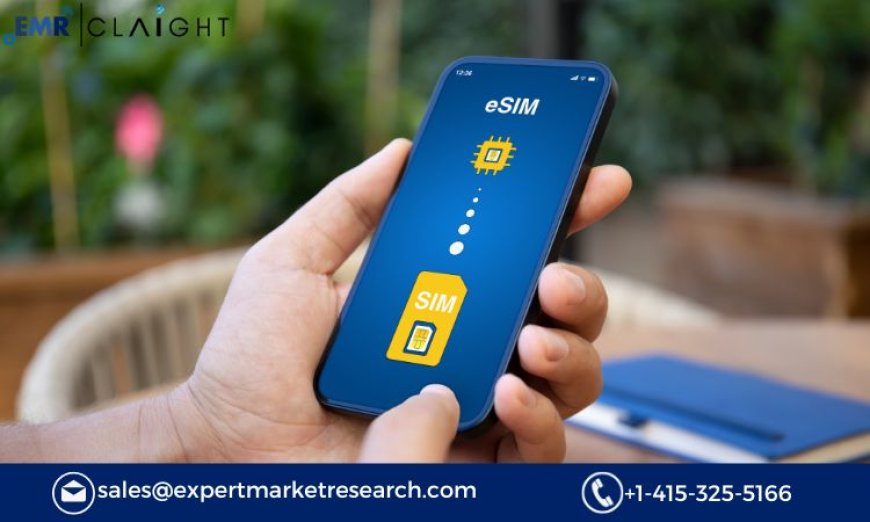eSIM Market Growth, Trends, Forecast, and Analysis (2025-2034)

The global eSIM market has rapidly gained traction in recent years, fueled by the growing demand for seamless connectivity in an increasingly digital world. The global eSIM market size reached around USD 12.78 billion in 2024, and it is projected to grow at a robust compound annual growth rate (CAGR) of 19.30% between 2025 and 2034, reaching nearly USD 74.63 billion by 2034. This remarkable growth is attributed to the increasing adoption of connected devices, the rise of the Internet of Things (IoT), and advancements in mobile technology. As eSIM technology continues to revolutionize connectivity across multiple sectors, it is poised to change the landscape of telecommunications, providing both users and businesses with greater flexibility, efficiency, and convenience.
Market Overview
eSIM, or embedded SIM, is a digital SIM that enables users to activate a cellular plan without the need for a physical SIM card. Unlike traditional SIM cards, eSIMs are built directly into a device, allowing users to switch between network carriers remotely, which enhances the user experience by offering more flexibility and convenience. eSIM technology has found applications in consumer electronics, connected vehicles, M2M (Machine-to-Machine) communications, and numerous other fields, driving the market’s growth. The transition from physical SIM cards to eSIMs is a natural progression in the quest for better connectivity solutions and the rising trend toward digitalization in the telecommunications industry.
By Solution
Hardware
The hardware component of the eSIM market plays a crucial role in enabling the deployment and functionality of eSIM technology. Hardware in the eSIM ecosystem includes chips, modules, and related components that are embedded directly into mobile devices, wearables, connected cars, and other smart gadgets. The growth of the hardware segment is primarily driven by the increasing number of consumer electronics and IoT devices, many of which rely on eSIM to facilitate seamless and flexible connectivity.
For example, smartphones, tablets, and smartwatches increasingly come equipped with eSIM technology, eliminating the need for a physical SIM card slot. As the adoption of 5G technology continues to rise, the demand for eSIM-enabled devices is expected to increase, further driving the market growth in the hardware sector.
Connectivity Services
Connectivity services are central to the eSIM ecosystem, enabling users to activate, manage, and switch between mobile carrier plans remotely. Remote SIM provisioning, which is a key feature of eSIM, allows users to switch carriers or data plans over the air (OTA), a process that is significantly more convenient than swapping out physical SIM cards. This feature is especially beneficial for global travelers who want the flexibility to switch between network operators without needing a new SIM card.
Additionally, telecom operators are increasingly offering tailored connectivity services, enabling businesses in various industries to deploy eSIM solutions at scale. As more enterprises adopt IoT devices and other connected solutions, the demand for eSIM-based connectivity services will continue to rise.
By Application
Consumer Electronics
The consumer electronics segment is one of the largest markets for eSIM technology. With smartphones, smartwatches, tablets, and other portable devices becoming an essential part of everyday life, the demand for eSIM-enabled devices is surging. eSIM allows consumers to avoid the hassle of physically swapping SIM cards when changing carriers, making the user experience more seamless. Furthermore, eSIMs help manufacturers create more compact, efficient, and durable devices by removing the need for a physical SIM card slot.
The global adoption of eSIM is further boosted by the growing trend of 5G technology, which is anticipated to significantly enhance mobile broadband speeds and overall connectivity. As 5G-enabled devices proliferate in the coming years, eSIM technology will play an essential role in supporting these devices' connectivity needs.
M2M (Machine-to-Machine)
Machine-to-Machine (M2M) communication is an increasingly important application for eSIM technology. M2M refers to the communication between devices and machines, without human intervention, and is at the heart of the IoT revolution. eSIM enables M2M devices to seamlessly connect and communicate over cellular networks without the need for physical SIM cards, making it easier to deploy and manage IoT solutions at scale.
Industries such as healthcare, agriculture, logistics, and manufacturing are using eSIMs in a variety of M2M applications, from remotely monitoring industrial equipment to tracking shipments in real-time. As the IoT ecosystem continues to expand, the need for efficient, scalable, and secure connectivity solutions like eSIM will grow significantly.
Connected Cars
Connected cars represent another key application of eSIM technology. Modern vehicles rely heavily on connectivity for a variety of functions, including navigation, in-car entertainment, telematics, and even autonomous driving features. eSIM plays a vital role in enabling these vehicles to stay connected to mobile networks without the need for a physical SIM card slot. Moreover, eSIM allows for easier carrier switching, enhancing the experience of users who travel internationally or between different network areas.
The increasing demand for connected cars, especially electric and autonomous vehicles, is expected to drive the widespread adoption of eSIM technology in the automotive industry. As automotive manufacturers embrace next-gen connectivity solutions, eSIM will become a central component in enabling smart, connected mobility.
Others
Aside from the key applications mentioned above, eSIM is also gaining traction in other sectors, such as healthcare, wearables, and smart home devices. In healthcare, eSIMs are being used to enable remote monitoring of patients through connected medical devices. In the wearable tech sector, eSIMs help users stay connected on the go, without needing to rely on their smartphones.
Furthermore, in the context of smart cities, eSIM technology is helping improve connectivity for various smart infrastructure elements like smart meters, traffic management systems, and public transportation.
Regional Analysis
North America
North America is a key market for eSIM adoption, driven primarily by the United States and Canada. The region has seen significant growth in the consumer electronics, automotive, and M2M sectors, all of which are adopting eSIM technology at an accelerating rate. Furthermore, the presence of major telecom operators and tech companies in the U.S. has led to significant investments in eSIM infrastructure and solutions. The roll-out of 5G networks in North America is expected to further accelerate the adoption of eSIM technology in the coming years.
Europe
Europe is also witnessing rapid adoption of eSIM technology, particularly in telecom, automotive, and IoT applications. The European Union’s regulations on telecom infrastructure, including policies promoting digitalization and green initiatives, are fostering the growth of eSIM solutions. Countries like Germany, the UK, and France are at the forefront of adopting eSIM in consumer electronics and M2M communication.
Asia-Pacific
The Asia-Pacific region is expected to be one of the fastest-growing markets for eSIM technology due to the large consumer base in countries like China, Japan, and India. The adoption of connected devices, as well as the booming IoT and automotive industries, is driving demand for eSIM solutions in the region. Moreover, the rapid rollout of 5G infrastructure in countries like China is creating significant opportunities for eSIM adoption.
Latin America
In Latin America, eSIM adoption is still in its nascent stages, but the market is growing steadily. Increased demand for connected devices and expanding telecom infrastructure is expected to drive the adoption of eSIM solutions. Countries like Brazil and Mexico are expected to lead the way as they embrace digital technologies and eSIM-enabled devices.
Middle East & Africa
The Middle East and Africa region is showing promising growth in eSIM adoption, particularly in the automotive, M2M, and consumer electronics sectors. The growing emphasis on smart cities, IoT solutions, and automotive innovation in the region is expected to boost eSIM market growth over the next decade.
Market Dynamics
SWOT Analysis
- Strengths: eSIM technology offers a flexible and user-friendly solution, enabling remote carrier switching, reducing the need for physical SIM cards, and supporting multiple devices.
- Weaknesses: eSIM adoption is currently slower in some regions due to infrastructure limitations and a lack of widespread consumer awareness.
- Opportunities: The rise of connected devices, 5G networks, and the Internet of Things (IoT) present significant opportunities for the expansion of eSIM.
- Threats: Traditional SIM card manufacturers and mobile operators may pose a challenge to eSIM adoption, along with regulatory hurdles in some regions.
Porter’s Five Forces Analysis
- Threat of New Entrants: Barriers to entry for new players are moderate due to the need for advanced technology and partnerships with telecom operators.
- Bargaining Power of Suppliers: Telecom operators have significant bargaining power in setting pricing structures for eSIM services and connectivity.
- Bargaining Power of Buyers: Consumers and businesses alike exert influence, particularly in the rapidly expanding consumer electronics and M2M markets.
- Threat of Substitutes: Alternatives like traditional SIM cards and Wi-Fi connectivity are still relevant, but eSIM’s flexibility and cost-effectiveness provide strong competition.
- Industry Rivalry: Competitive rivalry exists between telecom operators, eSIM solution providers, and hardware manufacturers, all vying for market share.
Competitive Landscape
Leading players in the eSIM market include telecom operators like Vodafone, AT&T, and T-Mobile, as well as technology companies like Qualcomm, Gemalto (Thales Group), and STMicroelectronics. These companies are investing in the development of advanced eSIM solutions and forming strategic partnerships to expand their market presence. The competitive landscape is shaped by technological innovation, the need for seamless user experiences, and partnerships with device manufacturers to incorporate eSIM technology into their products.
Key Trends and Developments
- 5G and eSIM Integration: The rollout of 5G networks worldwide is a major trend boosting eSIM adoption. The technology's ability to handle faster speeds, lower latency, and more connected devices aligns perfectly with the flexibility of eSIM.
- Sustainability: eSIM contributes to reducing e-waste by eliminating the need for physical SIM cards, a growing trend as industries focus on sustainability.
- Global Roaming: eSIM’s ability to switch carriers remotely makes it ideal for global travelers, offering a seamless experience without the need for physical SIM cards.
What's Your Reaction?


























